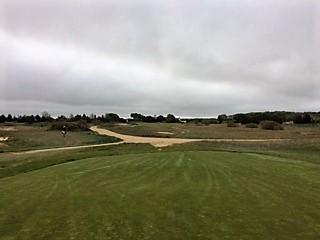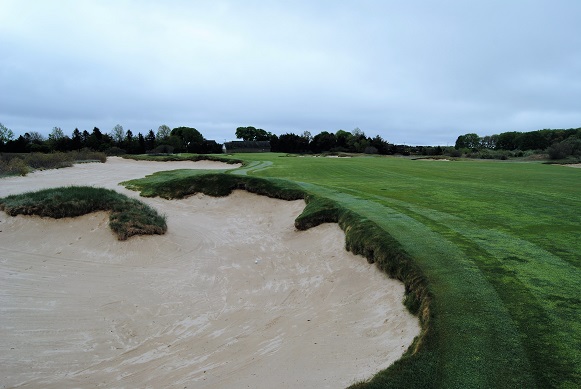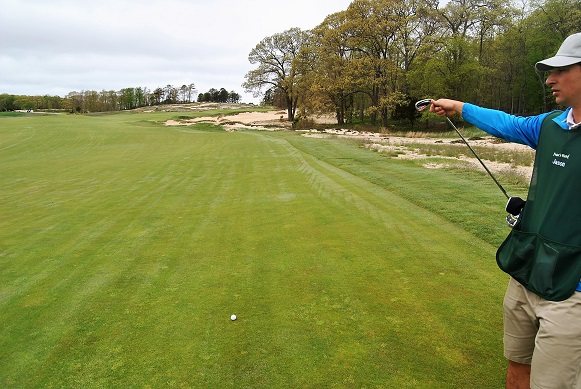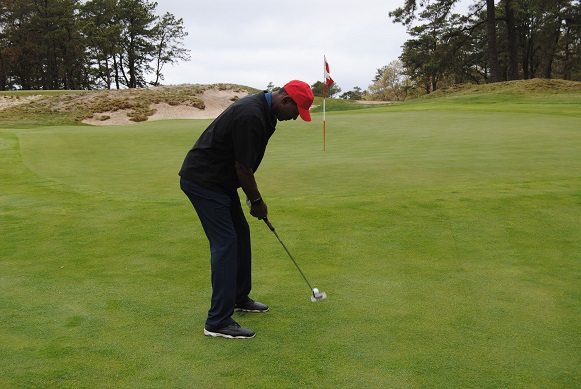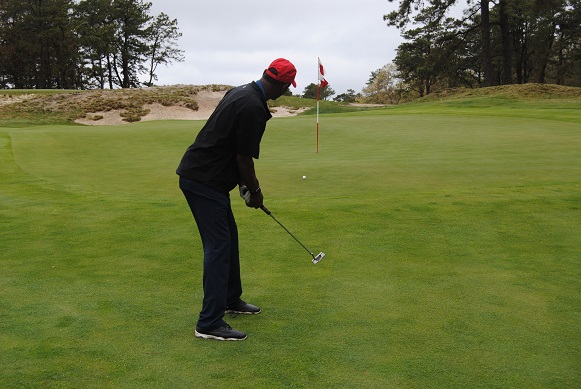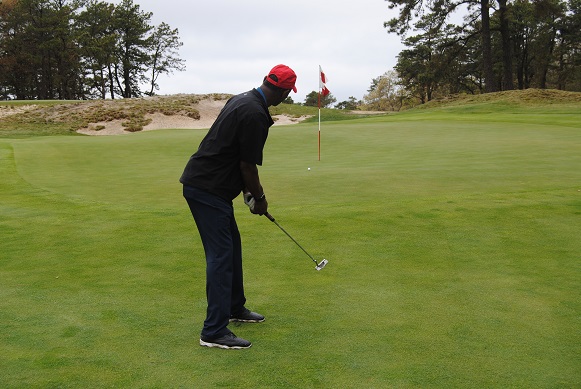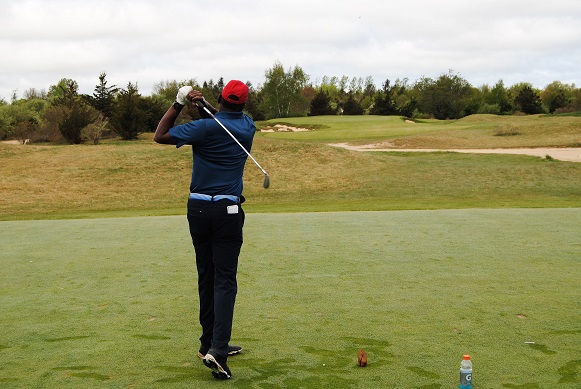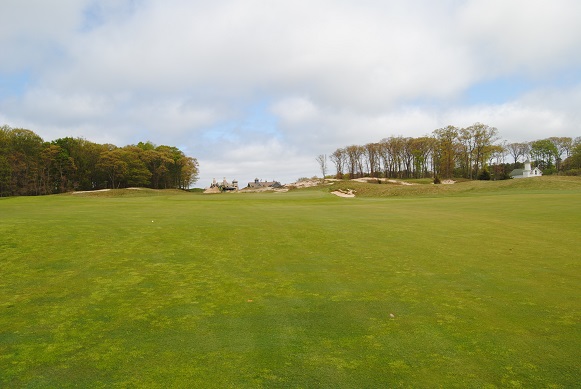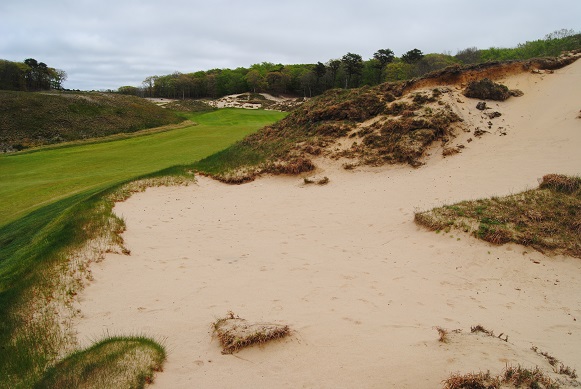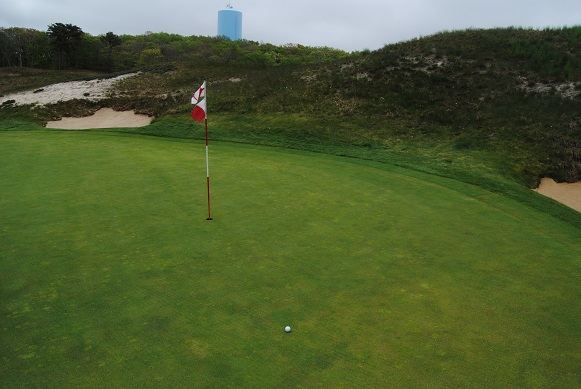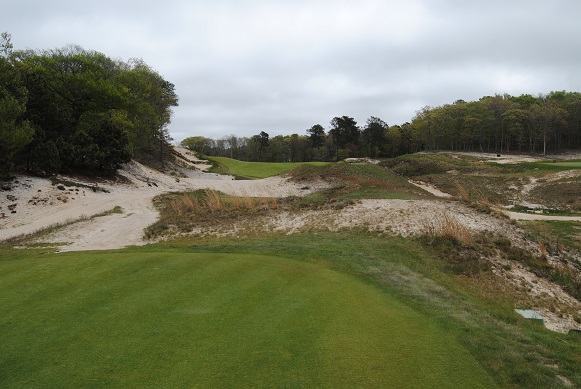The most intense week of my quest to play the top 100 courses in a year continued with my Thursday round at Friar’s Head. My round had been arranged by Mark Mongell, the Director of Golf at my home club, Cherokee Town & Country in Atlanta. The drive from my hotel to the Baiting hollow where the course is located was slightly shorter and slightly more scenic than my drive on the previous day to Sebonack. I was greeted at the bag drop by Shane. He took my clubs and directed me to the locker room where I met John, the locker room attendant.
I spoke with John about my quest and asked him what one piece of advice he would give on playing Friar’s Head. His response was swift and clear, “listen to your caddie.” Friar’s Head is a unique golf experience. The scorecard lists the holes and their par but provides no information on the length of the hole. There are also no distance markers on the course and mechanical devices are prohibited. You must rely totally on your caddie for distances. He carries with him a yardage sheet has the only tool for determining distances.
The course is another fabled design of Bill Coore and Ben Crenshaw. I loved playing Sand Hills, another Coore/Crenshaw creation and was very much looking forward to experiencing the uniqueness of Friar’s Head. After I changed my shoes, I headed over to the pro shop where I met Jake who had worked with Tori, the assistant pro from my club that Mark had asked to work with the team at Friar’s Head on the details for me to play there. I also had a few brief moments to chat with Adam McDaid, the Head PGA Professional at Friar’s Head. I let him know that Friar’s Head was the 75th course in my one-year quest to play the Golf Digest Top 100 courses in America. It was also my fourth course in three days.
After visiting in the Pro Shop and settling up, it was time to head over to the practice range with my caddie Jason. Jason is a student at the University of Colorado in Boulder where he is majoring in Finance. After warming up, Jason and I headed to the first tee. Another interesting feature at Friar’s Head is there are no rakes in the bunkers. Jason had a pole and the teeth of a rake that he carried with him. He could attach the two to rake a bunker if needed. It was my hope that it wouldn’t be needed.
Jason informed me that we would be playing from between 6700 and 6800 yards. He told me that he had a yardage book that would help us with distances. The scorecard in addition to not having distances, also didn’t have a slope nor rating for the course. What the scorecard did have was a statement that all-natural sandy areas on the course shall be treated as hazards. It went on to state one of the most practical statements that I’ve ever seen on a scorecard and I quote, “With respect to all other matters, common sense shall be exercised.” This was golf as it was meant to be.
The first hole is par four which Jason said was playing 350 yards. The fairway begins about 120 yards from the tee. There are trees that impinge on the left. The right is wide open with sand that borders. The fairway has a wide spot that bulges to the right at about 170 to 240 from the tee. It provides a generous landing zone. I decided to hit my three wood off the tee to take advantage of this nice gift by Misters Coore and Crenshaw. My tee shot landed in that zone on the right side of the fairway leaving 125 yards to the pin.
The green on the first hole is elevated so the approach shot was playing more like 135 yards. The only problem with taking advantage of the bulge in the fairway was that it left an approach shot that required a carry over sand all the way to the green. There were also trees near the green on the right. I expected my approach shot to draw. It didn’t. My ball landed on the slope between the bunker and the front of the green.
I was left with a very awkward stance but managed to chip to within six feet of the cup. Jason demonstrated his green reading ability by giving me a line that remained inside the cup but favored the left middle. I made the putt to open my round with a par.
The second hole is a par five that Jason estimated at 550 yards. The fairway is narrow. There is again a sandy area between it and the tee box. There is also a bunker along the left side that comes into play off the tee. Jason told me to aim my drive along the right edge of that bunker. I hit my drive 275 yards, leaving another 275 yards to the green.
While my ball was in the fairway, I was left with an awkward lie. The remaining 275 yards to the green had several bunkers along the right side of the fairway and one in the fairway at about 175 yards from where my ball was. I chose to hit a three hybrid to carry that bunker and leave a lob wedge for my approach shot. Unfortunately, I topped the ball and it traveled just 100 yards leaving me with 175 yards to the pin.
The green was slightly up hill, so I hit my five iron which is my 180 yard club right at the flag. The ball held its line and landed on the green but was 40 feet below the flag.
I missed my birdie putt five feet to the right but made the five-footer for my second par in a row.
The third hole plays 435 yards to another narrow fairway with bunkers and a sandy area on the left and several more bunkers along the right. Jason gave me a line and headed up the fairway to watch my drive. I misunderstood his instructions and hit the ball on the wrong line. I hit a 250 yard drive but the ball landed in the fairway and then rolled into the large bunker or sandy area off the left side.
I was left with 190 yards from the pin. I played it safe to ensure I got out of the bunker. I hit an eight iron to 60 yards from the middle of the green and 75 yards from the back-pin position.
I pitched on to 45 feet below the hole. I missed the cup on my par putt. The ball rolled six feet past the cup. I made the comeback putt for my first bogey.
The first par three on the course is the longest par three on the course. The fourth hole was playing 190 yards. There is again a sandy area immediately in front of the green. There are also several large bunkers off to the left and trees off to the right. The green is positioned closer to the sand on the left than it is the trees on the right. I hit a five hybrid off the tee and popped it up to the right.
I left my second shot short of the green. I then pitched on to eight feet but missed my bogey putt resulting in my first double bogey of the round.
The 310 yard fifth hole prompted a conversation between Jason and me regarding the appropriate club to hit off the tee. Jason initially thought I should hit a driver and try to drive the green. The hole is wide open. There is the usual sand in front of the tee box. It continues to the left of the fairway making the first 200 yards narrower than the last 100 yards. My concern with the driver option was that there is a bunker in the middle of the fairway at 230 yards from the tee.
If I didn’t carry the bunker, I could end up with a good tee shot, but a bunker shot to the green. I told Jason that I was certain that I could hit my three hybrid past the sand on the right, thus taking it out of play. While this discussion was going on, John’s words of wisdom to me during our locker room discussion were ringing in my head. Fortunately, Jason agreed that the conservative shot was a better bet. I hit hybrid to the middle of the fairway, 10 yards past the sand on the left.
My tee shot left me with 105 yards to a back right pin. I hit my sand wedge to 25 feet below the hole. My birdie putt missed the cup by six inches to the right. I tapped in for an easy par.
The walk from the fifth green to the sixth tee box takes you farther and farther from the sixth green. Jason pointed to a patch about 100 yards away and then headed in the other direction down the fairway. The hole was playing over 400 yards with a 200 yard carry over rough to an uphill fairway with bunkers along the left and an open field covered with fescue along the right. My drive landed short of the fairway. It was my worst and shortest drive so far during the round.
With the uphill fairway still in front of me and deep fescue to the right, I chose to lay up to 80 yards. I then hit my lob wedge right at the flag. The ball stopped 18 feet below the hole. I left my par putt short and settle for my second bogey of the round.
The seventh hole is the second par five on the course. The hole was playing 535 yards. There is sand off the beginning of the fairway to the right, but a 180 yard carry on the drive dispenses of it easily. Not so much for the bunker off the left side of the fairway that starts at 225 yards out or the sand all along the right side of the fairway that runs all the way to the green. I hit my drive 255 yards to the right side of the fairway.
With 270 yards remaining to the middle of the green and sand directly in front of me and all along the right side of the fairway, I attempted to lay up to 90 yards from the flag. I thought I could cut off the bunker and carry it with my five iron. I was wrong. My ball landed in the bunker leaving 105 yards from the middle of the green and 135 yards to a back-pin position.
My approach shot from the sand landed on the left edge of the green and kicked off. I chipped back on to 15 feet, the ball didn’t come down toward the hole as expected. I missed my left edge putt and settled for another bogey.
The par three eighth hole was playing 155 yards. The hole is pressed up against the trees on the right and has native sand along the left. The green is on an island within the sand. With a slight wind at my back, I thought I could get my 8 iron to the hole. I hit my tee shot right at the flag but left the ball just short of the front of the green.
I hit what I thought was a good putt, but the ball slide just below the hole to a foot past. I tapped in for a par.
The 375 yard par four ninth hole plays straight toward the club house. The fairway is one of the most generous ones on the course. It is bound on both sides by native sand. I tried to get the ball to the left side of the fairway but was aligned more right that I intended to be. The ball came to rest in the sand on the right, in between the edge and a clump of grass.
I was left with 140 yards to another back-pin position. My swing was too steep. The ball shot straight up. It came down 20 yards up the fairway. I hit my third shot to 25 feet left of the hole leaving a downhill left to right putt. I missed the putt to close out the front nine with a bogey and a score of 42.
The back nine at Friar’s Head opens with a 190 yard par three with the largest green on Long Island and probably one of the largest greens on the planet. The green is 62 yards deep and 35 yards wide. Even I couldn’t miss that green. The hole plays slightly uphill with is completely made up of sand except for the tee box and that massive green which has a 30 yard narrow strip of turf preceding it on the right front. There are trees off to the right and sand off the left that separates the tenth hole from the ninth hole.
I chose a three hybrid for my 190 yards uphill into the wind tee shot. The pin was on the back-left portion of the green, tucked behind a high mound off the front left of the green. I attempted to draw the ball around the mound. The ball stayed straight and landed on the right side of the green, 25 feet from the flag. I left my bird putt short and then cleaned up for a par to get the back nine off to a good start.
That good start came to a screeching halt on the 540 yard par five eleventh hole. The hole starts out with a very wide fairway which splits into two narrow strips at 250 yards from the tee. The right strip ends about 70 yards from the split, the left strips continues to the green. The two strips are separated by a mound covered with rough. I hit my drive to the middle of the fairway, just short of where it splits.
There is a comfort station just off the tee box of the 11th tee box. The short break was enough to allow my muscles to start to tighten. My body had held up well during this intense week of golf. I was on my fourth course in three days. I topped my second shot. I hit my third shot to 135 yards from the middle of the green. I missed the green to the right on my fourth shot, chipped on and two putted for my first double since the fourth hole.
I tried to stop the bleeding on the 180 yard par three twelfth hole, but my swing still didn’t feel fluid. I could feel my muscles continuing to tighten. The hole is fairly wide open with a bunker short of the green on the left and one along the right side of the green. I hit my tee shot to the right and short of the bunker along the right side of the green.
The pin was positioned in the middle of the green which sloped from right to left. To get close to the hole, I needed to pitch over the bunker. The safe play would have been to avoid the bunker by chipping to the left of the flag. I chose to pitch over the edge of the bunker and to the right of the flag. My gamble paid off. The ball stopped eight feet right of the flag. I expected it to roll down the slope, it didn’t.
Unfortunately, after getting to ball within 8 feet, I missed my par putt. I tapped in for my bogey.
The thirteenth hole is the longest par four on the course. Jason estimated the it was playing 470 yards. As if the length of the hole isn’t challenging enough, Mr. Coore and Mr. Crenshaw sprinkled several small bunkers along the right side of the fairway and in the middle of it over the first 375 yards of the hole. Then fairway starts 150 yards from the tee. There is also a lone bunker just short of the beginning of the fairway on the left which puts it at 150 yards from the tee, so it should be out of play. I hit my drive down the left side of the fairway. The ball faded, landed just right of the middle of the fairway and rolled further right, stopping just left of one of the bunkers off the right side.
I was left with 250 yards to the middle of the green. Jason and I decided that I should play conservatively and lay up short of a bunker cut into the left side of the fairway at 80 yards from the middle of the green. I then hit one of the purest five iron shots that I’ve ever hit. The ball flew 200 yards and landed in the left middle of the fairway leaving just 50 yards to the pin.
I hit my pitch thin and the ball rolled to the back of the green. I two putted from the back of the green for a bogey. As I stood on the tee box and after my short 220 yard drive, I would have been happy with a bogey. But after hitting my second shot to just 50 yards out, I should have been able to pitch the ball close enough to the pin to one putt for par. Well it was not to be.
The fourteenth hole is the last par five on the course. It measures roughly 520 yards. There is about a 200 yard carry over sand and rough to reach the fairway. There is a natural sandy area that separates the right side of the fairway from heavy trees for the first 165 yards after the fairway begins. There are also bunkers, natural sand areas and a cluster of trees along the left side. I hit behind the ball on my tee shot and the ball didn’t reach the fairway. It landed in a patchy area just short of it.
Because of the lie, I chose to hit the longest iron in my bag, my five iron. After all I had hit the best five iron ever on the previous hole. Well I didn’t repeat that. I hit the ball to the middle of the fairway, but only 80 yards.
My third shot was a mishit with my three wood. The ball landed in the right rough, sixty yards from the pin.
My pitch rolled off the green. I pitched back on and two putted for my second double bogey on a par five and third one of the round.
After the ultra-long 470 yard par four thirteenth hole, the 420 yard par four fifteenth hole seemed short. The fairway is situated below an elevated tee boxes that offers a beautiful picturesque view of Long Island Sound.
The wide fairway flows between sloping sand dunes and trees on the left and the right. I hit my drive down the middle of the fairway, leaving just 135 yards to a back-middle pin. The green is protected by a long narrow bunker that runs along the left side. I missed the green off the front right.
I chipped onto the green. The ball rolled to ten feet right of the flag. I sunk the putt for my first par since the tenth hole.
The walk from the fifteenth green to the sixteenth tee box is spectacular. It is along a boardwalk that clings to a sandy cliff that slopes toward Long Island Sound.
The sixteenth hole was playing 350 yards from another elevated tee box to a severely contorted fairway bounded by natural sandy areas and trees on the left and the right. My problems on the hole were caused by what started out as a nice drive, but turned into a hard kick into the only true fairway bunker on the hole. The bunker is at 235 yards from the tee box. My ball came to rest near the front lip of the bunker.
I decided to hit by bunker shot out to the left rather than go for the green. Smart choice, but poor execution. The ball carried farther than I expected and land in a very bad lie in the left rough.
Best I could do was to pitch back out to the fairway. I hit my fourth shot onto the green and two putted for my third double bogey on the back nine.
The seventeenth hole is the final par three on the course. It plays a mere 150 yards. The tee box on the hole is considerably larger than the small bicycle seat shaped green that is set at the base of a very large tree covered sand dune. The sand dune separates the green from Long Island Sound. There are bunkers off the left and right sides with natural sandy areas beyond the bunkers. My tee shot landed on the left side of the green and rolled off just into the rough.
My chip shot was right at the flag but rolled 10 feet past.
I missed my par putt and tapped in for a bogey.
All good things must come to an end. While I was struggling with my golf game on the back nine, I was still truly enjoying Friar’s Head. It’s a beautiful course with wide fairways and challenging approach shots. There was definitely no shortage of sand when the course was designed and built.
The 18th hole is a fitting finishing hole for this great Coore/Crenshaw experience. This par four measures 420 yards and plays to an uphill well undulated wide fairway framed with trees separated from the edges by natural sandy areas. My last drive of the round however wasn’t so fitting. I hit a short drive that didn’t make it to the crest of the hill at 160 yards from the green.
I was left with a 190 yard shot over the crest and then downhill. I topped my five iron. The ball rolled to 60 yards leaving 120 yards to a back-middle pin on a green with several bunkers off the left side.
My third shot landed on the green well left of the flag.
My par putt road the edge of the cup. I tapped in to end my round with a bogey, a disappointing 45 on the back nine and a total score of 87.
The good news was that my march toward playing all 100 courses was moving forward at a rapid pace. I had now three-quarters of the way through the courses. There were now 32 days and 25 courses remaining. The bad news was that after two days and two courses in the Hamptons I had not made any progress on gaining access to Shinnecock Hills. I was still hopeful that fate would intervene and provide a pathway to Shinnecock Hills. It just wasn’t ready to do so yet, but there was always tomorrow when I’d be right next door.





